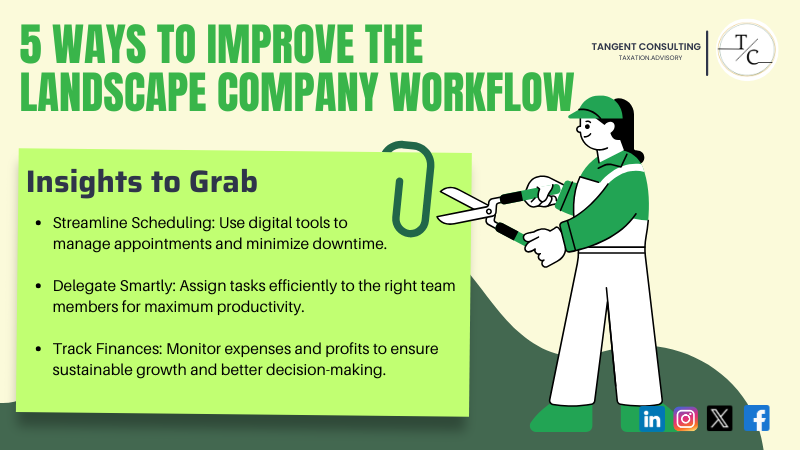5 Ways to Improve the Landscape Company Workflow
5 Ways to Improve the Landscape Company Workflow

Friday Mornings are always busy and who can understand better than all the busy landscapers out there. The pressure mounts as the day goes by.
It’s completely ok as this is part of the business, but if every day is messed up for you and you can’t seem to navigate the chaos, then we need to talk about your landscape company workflow.
As you read through, you’ll get to know the 5 practical ways to improve your workflow. So, you manage your landscaping business like a pro.

What is Workflow Management?
At Tangent, we are big on organized work. Whether it’s about organizing receipts or organizing financial statements, we emphasize a tidy approach.
Workflow management is kind of similar. It’s about creating a structured approach to your daily operations like assigning tasks, scheduling jobs, tracking progress, and ensuring that nothing falls through the cracks.
How Does it Work?
To understand workflow, you need to understand three things:
- Processes: The step-by-step actions you need to take to complete a task, like planning a landscaping project or following up on customer quotes.
- Tools: The software and systems that help you track and automate those processes. This could be anything from job scheduling software to CRM tools.
- People: Your team members’ roles and responsibilities.
If you do it properly, workflow management eliminates bottlenecks, eliminates wasted time, and simplifies the overall business.

5 Tips for a Smooth Landscape Company Workflow
Did you know businesses waste an average of 20-30% of their revenue due to inefficiencies?
If we apply this stat to any struggling landscaping company, this could mean lost time on poorly planned schedules, miscommunications between teams, or missed opportunities.
To illustrate this better, let’s give an example. Each inefficiency in your day-to-day operations acts like a weed in a garden—small at first but eventually overgrowing and choking your profitability.
So, let’s explore five actionable tips to improve landscape company workflow.
1. Optimize Pricing
Many small businesses undercharge for their services. This is because they fail to account for hidden costs like labor, materials, and travel. This can quickly erode profit margins, especially on larger projects.
To optimize your pricing, start by breaking down all your costs—direct and indirect. Include factors like equipment depreciation, fuel costs, and even administrative expenses.
Once you have a clear picture, build a pricing model that reflects both your costs and the value you deliver to clients.
Here’s the thing: optimizing pricing doesn’t just boost profitability—it also improves workflow. When your pricing is consistent and clear, your team can focus on executing projects without last-minute adjustments or client negotiations.
Pro Tip: You can use landscaping software like Jobber for pricing strategies.

2. Hire Effectively
Hiring the right people can make or break your workflow. Here, we need to emphasize that it’s not just about finding skilled workers; it’s about bringing people who align with your company’s values, can communicate effectively, and are eager to learn.
To hire effectively, you can start by clearly defining each role in your business. You need to answer questions such as, are you hiring a crew leader who can oversee projects or a crew member who’ll focus on specific tasks?
Next, look for soft skills like problem-solving, time management, and teamwork. A landscaper who can adapt to changing client requests or a foreman who can effectively coordinate with the team can save you plenty of time.
3. Automate Invoicing
Invoicing might not be the most s*** part of your landscaping business, but it’s super important. Manual invoicing can be a time waster, filled with errors, and chasing down payments can be difficult.
So, to solve this problem, you need to automate. It’s a simple way to organize your invoicing process and keep your cash flow healthy.
You can use tools like Jobber or QuickBooks to generate and send invoices instantly, set up recurring billing for repeat clients, and even automate payment reminders.
Automation doesn’t just improve your workflow—it enhances your client experience. Clients appreciate clear, professional invoices and the convenience of multiple payment options. Plus, you can comfortably track payments whenever you want.

4. Manage Your Inventory
Imagine arriving at a job site only to realize you’re missing essential tools. Poor inventory management is like that, and it can disrupt your workflow.
The key to avoiding this is to have an efficient inventory management system.
You can start by taking note of what you have, what you need, and how frequently you use certain items. Categorize your inventory into essentials, seasonal items, and speciality tools or materials. This makes it easier to track what’s running low and ensures you’re always prepared for upcoming jobs.
5. Do Marketing
Marketing isn’t just about getting your name out there—it’s about building relationships, showcasing your expertise, and positioning your business as the go-to solution.
Start by understanding your target market. Are you focusing on residential homeowners, commercial properties, or both? Once you know your audience, you can create a customized marketing plan.
You can try online and offline strategies. Build a strong presence on social media platforms like Instagram and Facebook, where you can share before-and-after photos of your work, customer testimonials, and even landscaping tips.
You can also try local SEO. Register your business on Google My Business and encourage satisfied clients to leave reviews. Local searches like “landscaping services near me” are a goldmine for attracting new customers.

Final Thoughts
So, there you go! Wasn’t it easy? You bet it is. With the right landscape company workflow, you can organize your business effectively.
It’s important to remember that you don’t need to manage everything at once. Start with one tip, implement it and move on to the next. You see, small, consistent changes lead to big results over time.
Speaking of solid results, Tangent Consulting has years of experience working as a business coach and CFO with landscaping businesses. With us, you don’t need to hire an accountant or business coach separately when you can get both in one place.
PS If you are reading this, it means you can have access to our free consultation for your landscaping business. Avail this for free today before we change our mind 😉
FAQs
What are the costs involved with landscaping?
Landscaping costs typically include labor, materials, equipment, and overhead expenses such as fuel and maintenance.
What is the profit margin for the landscape industry?
The average profit margin for landscaping businesses ranges from 5% to 20%.
What is most profitable for a landscaping business?
Specialized services like landscape design, hardscaping, and maintenance contracts are often the most profitable, as they offer higher margins and recurring revenue.
